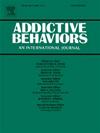寻求精神疾病帮助的青少年的物质使用模式:一个潜在阶层分析
IF 3.7
2区 医学
Q1 PSYCHOLOGY, CLINICAL
引用次数: 0
摘要
物质使用在年轻人中很常见,成年初期是发展物质使用障碍(SUD)和精神疾病的高风险时期。接受心理健康治疗的青少年药物使用率高于同龄人,这为早期干预sud提供了机会。为了促进这一点,需要更好地了解寻求帮助的青少年的物质使用模式。目的:我们采用探索性和验证性潜类分析(LCA)来根据青少年的物质使用模式确定参加精神卫生服务的离散类别,并评估群体之间在人口统计学、生活质量(QOL)和精神症状方面的差异。研究对象为寻求治疗的青年(15 - 25岁),从headspace(澳大利亚全国青年重点初级精神卫生服务网络)中招募,分为2个队列(研究1,n = 676,女性= 67.8%;研究2,n = 295,女性= 66.3%)。测量包括人口统计学、终生和最近的物质使用、精神健康症状和生活质量。结果探索性LCA(研究1)揭示了四类物质使用模型:1)当前酒精或无物质使用(ALC), 2)当前烟草、酒精和大麻使用(TAC), 3)过去使用多种物质,4)当前使用多种物质。目前多物质使用组比ALC组报告更多的心理困扰,比没有多物质使用(ALC和TAC)的青少年更低的生活质量。验证性LCA(研究2)确定了四个相似的类别,但在痛苦或生活质量方面没有观察到组间差异。结论:研究结果确定了在接受精神卫生保健的青少年中具有临床意义的物质使用模式,这对发展早期干预措施以解决这一风险高人群的物质使用问题具有重要意义。本文章由计算机程序翻译,如有差异,请以英文原文为准。
Substance use patterns among youth seeking help for mental illness: A latent class analysis
Background
Substance use is common among youth, with emerging adulthood a high-risk period for developing both substance use disorder (SUD) and mental illness. Youth receiving mental health treatment have higher rates of substance use than their peers, providing an opportunity for early intervention for SUDs. To facilitate this, a better understanding of substance use patterns among help-seeking youth is needed.
Objectives
We employed exploratory and confirmatory latent class analyses (LCA) to identify discrete classes of youth attending mental health services based on their substance use patterns, and assessed differences between groups in demographics, quality of life (QOL) and psychiatric symptoms.
Methods
Participants were treatment-seeking youth (15 − 25 years) recruited from headspace, Australia’s national network of youth-focused primary mental health services, in 2 cohorts (Study 1, n = 676, female = 67.8 %; Study 2, n = 295, female = 66.3 %). Measurements included demographics, lifetime and recent substance use, mental health symptomatology and QOL.
Results
Exploratory LCA (Study 1) revealed a four-class model of substance use: 1) current alcohol or no substance use (ALC), 2) current tobacco, alcohol, and cannabis use (TAC), 3) past polysubstance use, and 4) current polysubstance use. The current polysubstance use group reported more psychological distress than the ALC group and lower QOL than youth without polysubstance use (ALC and TAC). Confirmatory LCA (Study 2) identified four similar classes, however no differences between groups in distress or QOL were observed.
Conclusion
Findings identify clinically-significant substance use patterns among youth accessing mental health care, with implications for development of early interventions to address substance use in this risk-enriched population.
求助全文
通过发布文献求助,成功后即可免费获取论文全文。
去求助
来源期刊

Addictive behaviors
医学-药物滥用
CiteScore
8.40
自引率
4.50%
发文量
283
审稿时长
46 days
期刊介绍:
Addictive Behaviors is an international peer-reviewed journal publishing high quality human research on addictive behaviors and disorders since 1975. The journal accepts submissions of full-length papers and short communications on substance-related addictions such as the abuse of alcohol, drugs and nicotine, and behavioral addictions involving gambling and technology. We primarily publish behavioral and psychosocial research but our articles span the fields of psychology, sociology, psychiatry, epidemiology, social policy, medicine, pharmacology and neuroscience. While theoretical orientations are diverse, the emphasis of the journal is primarily empirical. That is, sound experimental design combined with valid, reliable assessment and evaluation procedures are a requisite for acceptance. However, innovative and empirically oriented case studies that might encourage new lines of inquiry are accepted as well. Studies that clearly contribute to current knowledge of etiology, prevention, social policy or treatment are given priority. Scholarly commentaries on topical issues, systematic reviews, and mini reviews are encouraged. We especially welcome multimedia papers that incorporate video or audio components to better display methodology or findings.
Studies can also be submitted to Addictive Behaviors? companion title, the open access journal Addictive Behaviors Reports, which has a particular interest in ''non-traditional'', innovative and empirically-oriented research such as negative/null data papers, replication studies, case reports on novel treatments, and cross-cultural research.
 求助内容:
求助内容: 应助结果提醒方式:
应助结果提醒方式:


